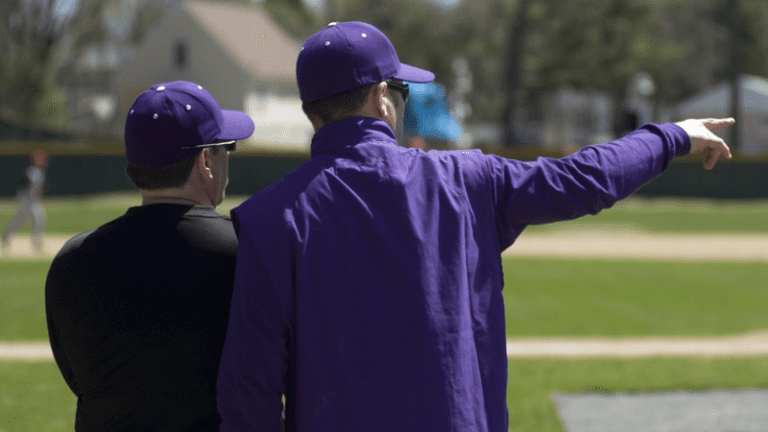Sooner or later, most high school baseball players will attend some kind of prospect camp or recruiting “showcase”. These events give college coaches the opportunity to see many players at one location and to rate their baseball “tools”. Most of these events follow a format that was developed many years ago by Major League Baseball when pro teams offered open tryout camps to high school and college players. The typical basic order of events is 1) timed 60 yard dash, 2) arm strength evaluation from your primary position, 3) batting practice and 4) pitching evaluation. Here are some important tips that can make a difference for you on “showcase day”.
- DON’T attend a camp or showcase event if you are injured! Coaches at these events assume you are 100% healthy. It doesn’t help your cause to be evaluated when you have a slight hamstring pull, a sore arm or you just pitched a full game two days ago.
- You only get one chance to make a good first impression! Show up at the event on time (on time means be there early). You don’t want to be rushed or be in a panic by arriving late. Be polite – use “yes, sir” and “no, sir” when speaking to coaches and staff.
- Look like a player! Look sharp. Make sure you have positive body language. College coaches and pro scouts typically aren’t impressed by multiple earrings, gaudy chains & necklaces, sloppy appearance, etc. Let your performance on the field be what they remember, and hustle at every opportunity!
- During the stretching/warm-up period, feel free to do more stretching if you need it. Do whatever you need to do to get yourself ready!
60 Yard Dash Tips
- During the 60 yard dash, players may run according to alphabetical order, lowest number to highest number, etc. If you can see that you won’t be running for a while, make sure to keep yourself loose. Don’t just stand in line – it’s OK to jog around and keep moving.
- Depending on the event, college coaches, pro scouts and showcase directors may be standing at the finish line with their stopwatches. Most coaches and scouts start their watch WHEN THEY SEE YOU MOVE. You are NOT helping yourself if you start leaning or moving early before the start. You’ll actually end up with a slower time. If you slip or trip during the start, just stop. You’ll be given the opportunity to start again.
- Don’t coast to the finish line. Act like you are running 65 yards instead of 60 and finish strong! Lean forward coming across the finish line, just like a track sprinter.
Defensive Tips
- During the throwing segment, keep yourself loose if you are a player farther back in the waiting line. Some players do their throwing warm-up and then have to stand in line for 15-20 minutes waiting for their turn. It’s OK to grab a partner and make a few extra tosses to keep yourself warmed up. Just be ready when your name or number is called.
- For infielders and outfielders, coaches are mainly evaluating arm strength and the carry of the ball. Accuracy is a bonus. At these events, many coaches would rather see you throw the ball over somebody’s head at 85mph instead of throwing 75mph and hitting the target. On catcher pop times, coaches want to see a quick release but they also want to see the ball end up near the bag at 2nd base. Many catchers try too hard to be quick with their release and end up with multiple balls dropped at home plate. Coaches notice this.
- Outfielders will usually make throws from RF to either 3rd base or to home, or both. An infielder will usually be positioned as a relay man, but they won’t be cutting off your throws. Infielders will be making throws to 1st base, with first basemen making throws to 3rd base. Sometimes an event will have you make a few double play feeds. Infielders: you can expect to have a couple of grounders hit directly at you, then a ball or two to both your backhand and forehand sides. The last play will be a slow roller.
- There’s nothing wrong with trying to dive for a ball during the throwing evaluation. The fungo hitter is supposed to hit you balls you can handle but they’ll make a mistake once in a while. Making a diving play is a bonus and coaches like to see the effort.
- Throw from the defensive position where you think you can show off your arm the best. Ideally, this should be your best position. Most showcases do NOT allow players to throw from more than one position. The exception is made for players whose secondary position is catcher. Coaches want to get pop times on any player who is willing to put on the catcher’s gear. If your primary position is infield or outfield, it doesn’t hurt you to also make throws during the catcher evaluation segment.
Offensive Tips
- The hitting segment at showcases can be stressful because you may only get one round of 8-10 swings. Hopefully there is some kind of warm-up station with batting tees or partner flip drills. When your group gets ready to hit live, do your homework and time up the BP pitcher. Study him in the on-deck circle just like you would in a game. I suggest you TAKE the first BP pitch during your round – just to help your timing. Major League hitters in a home run derby contest take a bunch of pitches early to get their timing down.
- Coaches are looking for hard contact – line drives! Square it up! Ideally, you show some bat control by hitting some line drives to all fields, not just to the pull side. If hitting for power is something you do well, coaches like to see a few balls hit deep into the gaps.
Pitching Tips
- During the pitching evaluation, coaches and scouts are evaluating your velocity, movement, location and changing speeds. They watch your delivery mechanics, arm angle, alignment and more.
- Work on throwing low strikes with your fastball, mixing in your off-speed pitches. Show some command.
- Don’t be afraid to “cut loose” with a couple of fastballs at the end!
Mental Tips
- In everything you do, be conscious of body language! Never hang your head. Look confident! It’s OK to be nervous. Take a deep breath or two to slow things down and get yourself focused. Try not to worry about things you can’t control like bad hops or a poorly hit ball from the fungo hitter. Slow down and do your best to take things “one pitch at a time”.
- Assume some coach is always watching you. Don’t be the player who leans against the fence talking to his girlfriend during a break in the action. Don’t be the player yelling at his mom to “get me a Gatorade!” Remember, you only get one chance to make a good first impression!
THE RECRUITING COACHES (@TheRecruitingCo) helps families navigate the tricky waters of the college recruiting process by providing the most truthful advice and hands-on guidance. Our coaches are all former college athletes and college coaches. You can learn more about how we can help your recruiting process here.
How useful was this post?
Click on a star to rate it!
Average rating 5 / 5. Vote count: 27
No votes so far! Be the first to rate this post.


